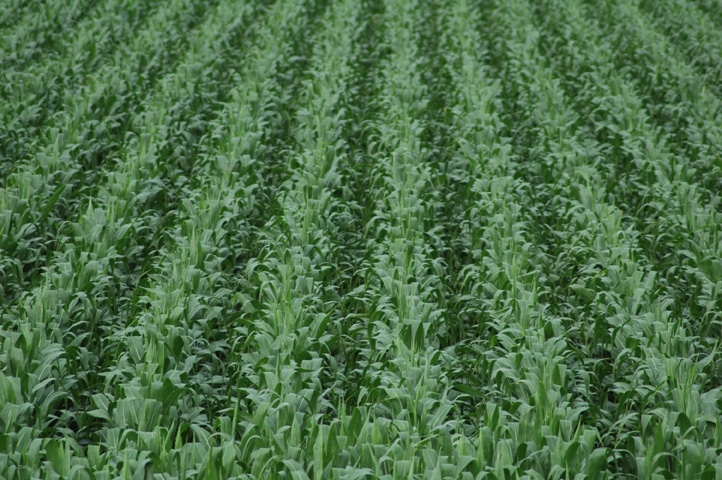July 14, 2015

The USDA released new projections for the 2015-16 corn marketing year in the July 10 World Agricultural Supply and Demand Estimates (WASDE) report. Marketing year-ending stocks for corn are expected to be 172 million bushels smaller and the average farm price is expected to be 25¢ higher than projected a month earlier. Darrel Good, a University of Illinois agricultural economist, says uncertainty surrounding these projections is likely greater than is normally the case for this time of year.
“Stocks of old-crop corn at the beginning of the 2015-16 marketing year are projected at 1.779 billion bushels, 97 million bushels less than the June projection and 302 million less than projected in October 2014,” said Good. “Corn consumption during the current marketing year is expected to exceed last month’s projections in all three major consumption categories.”
Good reported that the projection of feed and residual use was increased by 50 million bushels to a total of 5.3 billion in response to the smaller-than-expected inventory of corn on June 1. Use for ethanol and by-product production was increased by 25 million bushels to a total of 5.2 billion in response to the higher-than-projected rate of ethanol production in June and higher forecasts of gasoline consumption. The export projection was increased by 25 million bushels, to a total of 1.85 billion in response to the current pace of shipments and sales. In addition, the recently released Census Bureau export estimate for May exceeded USDA export inspections by 10 million bushels.
The forecast of harvested acreage of corn for grain in 2015 was reduced by 0.6 million acres, reflecting the estimates in the USDA’s June Acreage report.
“The extremely wet weather in the eastern Corn Belt during June has created some uncertainty about the magnitude of planted and harvested acreage of corn in 2015,” Good said. “Clarification about acreage will come slowly, with the USDA’s October Crop Production report likely to provide a good forecast of the final acreage estimates. The market will look for acreage clues in the early USDA Farm Service Agency reports of planted and prevented acreage expected in August and September. The fact that planted acreage of corn was less than June intentions in 14 of the past 19 years, along with the late planting season in some areas, suggest that the final acreage estimate will be smaller than the June forecast this year.”
As expected, the projection of the average 2015 corn yield remained unchanged at 166.8 bushels because that projection is based on a trend-adjusted weather model adjusted for timeliness of planting and assumes average July weather. Additionally, crop condition ratings remained quite good in the first week of July.
“It appears that many market participants believe that yield potential has been reduced below 166.8 bushels due to the extremely wet weather in the eastern Corn Belt,” Good said. “The USDA will release the first survey-based yield forecast on Aug.12. Between now and then, yield expectations will largely be based on the USDA’s weekly crop condition ratings. Corn yield models based on trend-yield and end-of-year crop ratings generally show a yield change of about 0.6 bushel for each one point change in the percentage of the crop rated in good or excellent condition,” he said.
Corn consumption
On the consumption side, the July WASDE projections are for a 25-million-bushel year-over-year reduction in feed and residual use, and a 25 million bushel increase in both exports and ethanol use of corn.
“The lower projection for feed and residual use compared to both last year’s use and last month’s projection is attributed to a smaller crop production projection, higher corn prices, and larger supplies of distillers’ grains,” Good said. “The increase in distillers' grains production, however, is expected to be very small and will likely be more than absorbed by larger exports. The key to feed use during the year ahead will likely be the pace of hog production and the pace of replacing the layer flock that has been reduced by bird flu,” he said.
According to Good, the higher projection for ethanol use of corn reflects the projection of increased domestic gasoline consumption.
Corn exports
The export forecast is 25 million bushels larger than the projection for the current year, but 25 million bushels smaller than last month’s projection. The smaller projection this month reflects expectations for increased export competition from Brazil stemming from the large 2015 harvest. However, Brazilian production and exports are expected to decline in 2016. Stocks of corn at the end of the 2015-16 marketing year are projected to be 1.599 billion bushels, 180 million bushels smaller than stocks at the beginning of the year. The marketing-year average farm price is projected in a range of $3.45 to $4.05.
“In years with substantial production uncertainty, prices tend to be above the subsequent marketing-year average during the growing season, offering producers the opportunity to forward price a portion of the crop,” Good said. “That pattern seems to be unfolding this year. New-crop corn prices are currently above both the spring price for crop revenue insurance and above the upper end of the range of the USDA’s marketing-year average price projection. Still, prices could trade in a relatively wide range over the next 10 weeks.
“Pricing decisions remain difficult for producers, particularly for those with substantial production uncertainty,” Good said. “Risk can be mitigated with a combination of incremental sales at higher prices and options strategies that provide a floor above the crop revenue price of $4.15 for December futures.”
You May Also Like




